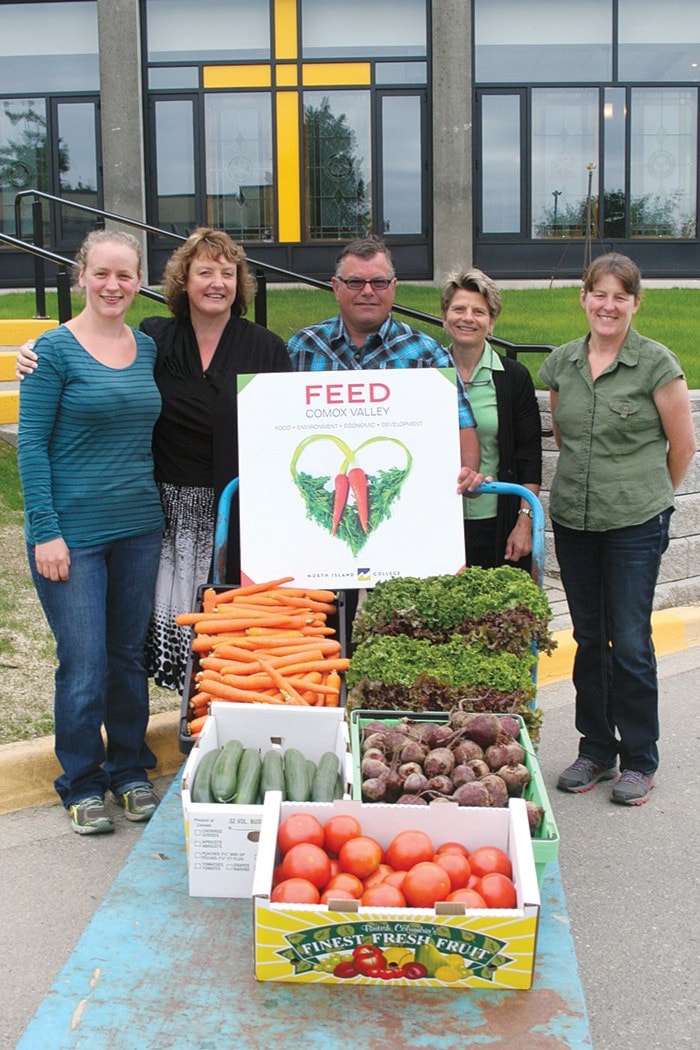Patients at St. Joseph’s General Hospital, residents at Glacier View Lodge and students at North Island College are enjoying freshly picked vegetables, thanks to a project geared at increasing the supply of local food in public institutions.
The project — dubbed FEED (Food, Environment and Economic Development) Comox Valley — is establishing a new food model for institutions that is not dependent on imported vegetables from the U.S.
"It is time to re-localize our food system and revitalize our economy," said project lead Sandra Hamilton, who would like to see the creation of a regional food hub in the Valley.
But is there enough local demand within 100 kilometres to instal warehousing, cold storage and other necessary infrastructure?
"The next step is a peel and chop facility," Hamilton said. "All of that is jobs. It's an exciting conversation."
By going direct from the farm to the hospital, she says the farmer gets the highest price possible, at the same price the hospital is already paying,
"We in British Columbia have the highest percentage of old farmers — I think it's 60 per cent over 60 — but more worryingly, we have the lowest percentage in Canada of young farmers, which is 0.6 per cent under 40. What are we going to do to make it viable for the next generation? That's why the hospitals and the seniors homes are such an important market because they provide stability of demand."
She notes the predictability of institutions in terms of patients/residents, number of beds and diet, which is usually on a two or four-week rotation.
"You can define it a year in advance," Hamilton said.
St Joe's and Glacier View purchases tomatoes, cucumbers, lettuce and potatoes from Sieffert's Farm, as well as carrots, onions and peppers.
"Sieffert's grows lovely lettuce, and the baby potatoes taste like butter," said Wanda McMillan, director of nutritional services. "We're thrilled to be supporting our local farmers. We're getting the products at a much quicker rate…We're somewhat limited on what's available. They pick it one day and they deliver it to us the next day."
Island Health is awaiting the outcomes of the pilot FEED project.
"We're very supportive of getting local food into hospitals, and using more local foods," said Lynn Nabata, director of food services for Island Health. "We're looking forward to working with Sandra more in the future."
Hamilton notes the need for more volume to supply further institutions, such as the new regional hospital under construction by the college.
"We have one more growing season before the new hospital opens," she said.
Come fall, Hamilton hopes to determine the number of carrots and potatoes needed, and to have farmers buy the seeds and grow to order next year for local institutions.
"Then the farmers can plant higher volumes."
There was a time — 1950 to be exact — when farmers produced 85 per cent of the Island's food. These days, however, an estimated 96 per cent of food is coming by fridge and ferry. The remaining four per cent is milk.
"Basically, we have no capacity to feed ourselves right now," Hamilton said.
A report, Wake-Up Call: California Drought & B.C.’s Food Security, found that B.C. produce prices increased between 5.7 and 9.6 per cent last year. If these trends continue for the next five years, price increases of 25 to 50 per cent are predicted for many fruits and vegetables.
"One of the things that saddens me is there's still a lot of under-utilized or non-utilized good quality farm land on the east coast of Vancouver Island," said Comox Valley MLA Don McRae, who notes the Valley's roughly 500 farms grow an estimated 180 of B.C.'s 220 agricultural products.
"We have the ability to provide a huge range of product, let alone seafood as well," he said. "I think she's (Hamilton) got a great idea. The challenge she has is, too many farmers, even a big Comox Valley farm, might not have the capacity to consider this on its own…Can they work with a handful of other farmers to create these processing facilities that are necessary."
Hamilton says health authorities could easily re-structure food contracts — which would enable farmers to bid on them, without numerous multi-national companies coming between them.
"Why do we need three to seven multi-national food companies to get a potato into a hospital?" she said. "What we do now is we lump these massive contracts together. The companies have to bid on the whole thing. Fresh, local food needs to be pulled out of these contracts, so that our farmers can bid on it fairly. They don't have access to those contracts right now."
McRae said politicians aren't the ones who sign the contracts. But he loves the idea she's pushing — signing contracts to give flexibility to bring more local agricultural product into institutions.
"I think it's the going-forward contracts that are the real strength that we need to encourage farmers to advocate for," he said.
Hamilton said conversations are starting about how to replicate the FEED model across Vancouver Island.
"FEED Comox Valley has successfully demonstrated that trade agreements, price and food safe are not the insurmountable barriers we once believed them to be," she said.
Hamilton has been invited to present proposals at the Union of B.C. Municipalities (UBCM) and at the Association of Vancouver Island and Coastal Communities (AVICC) in the fall.
